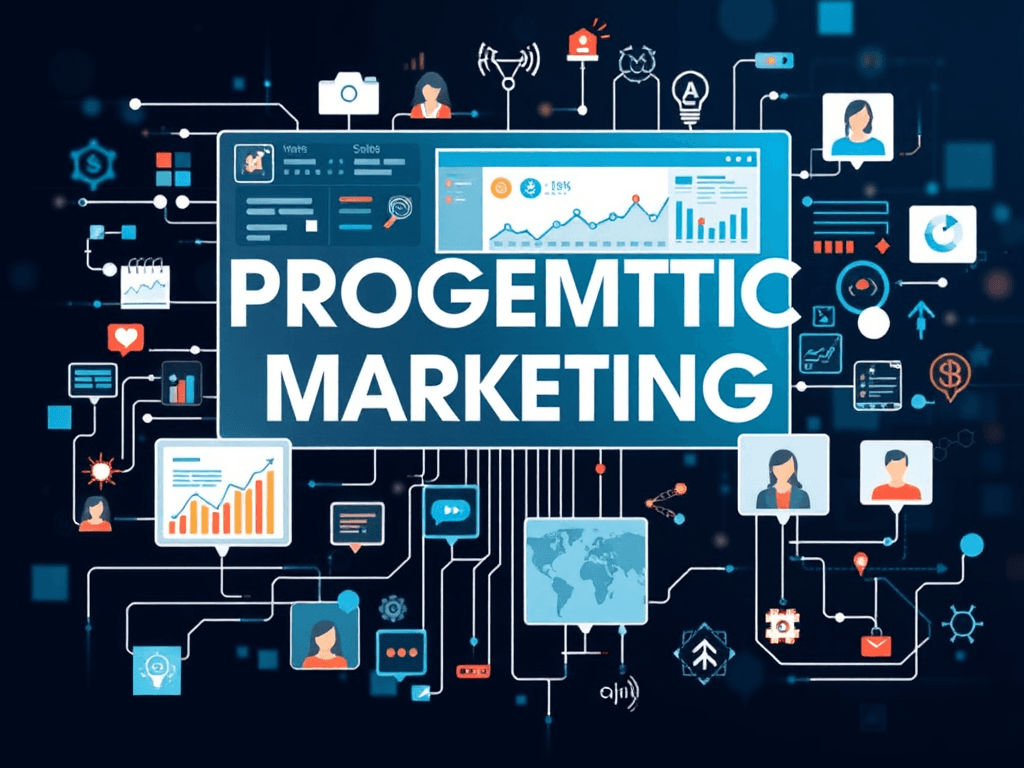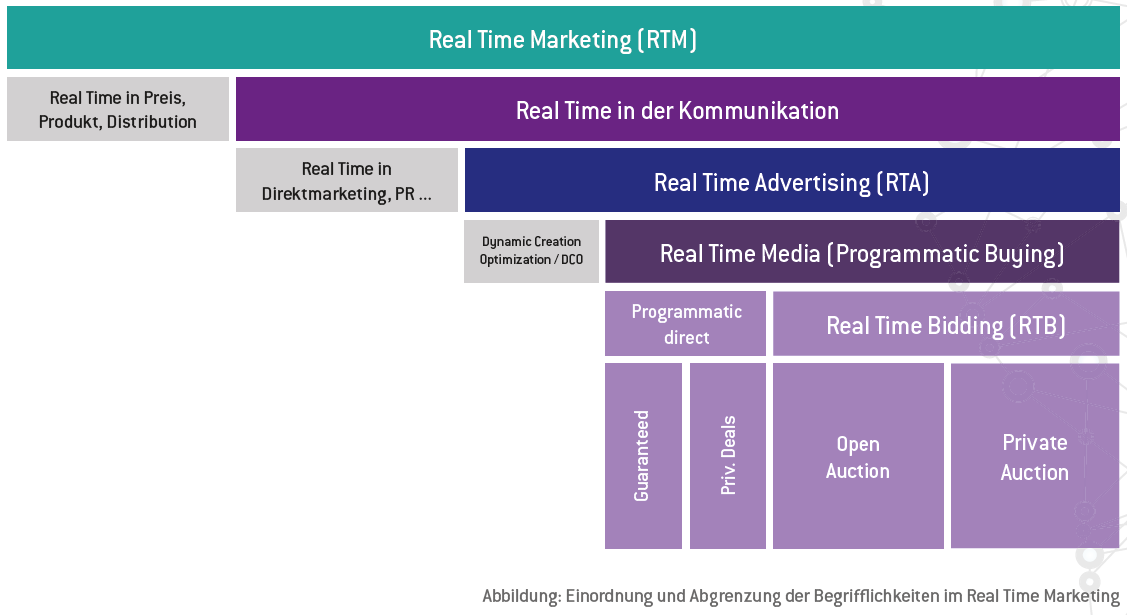What is Programmatic Marketing and How Does It Work?
By RG team · 10 min read
Last Updated on June 11, 2023
Wait a minute...

Introduction

As a content creator, the digital advertising landscape can seem intimidating and challenging to navigate. However, programmatic marketing provides an automated, advanced advertising strategy, offering precise targeting tactics to segment audiences with real data, which results in hyper-targeted, effective ads. Programmatic marketing involves automated, real-time bidding that purchases ad inventory for you, allowing you to advertise to specific users in specific contexts. In this article, we will dive deeper into programmatic marketing, from its definition, benefits, types to how it works, targeting, and case studies of successful programmatic advertising.
But first, let's define programmatic marketing. According to WebFX, "programmatic marketing describes an advanced marketing strategy that uses an automated, real-time bidding process that purchases ad inventory for you, allowing you to advertise to specific users in specific contexts, which results in hyper-targeted, super-effective ads." Essentially, programmatic marketing is the use of software to buy digital advertising automatically, which is different from traditional advertising methods. The former uses requests for proposals, while the latter involves the use of algorithms for media buying. Programmatic marketing involves the precise placement of automatic ads and is considered a more effective strategy since the ads reach an audience interested in viewing them, hence the term targeted ads.
What is Programmatic Marketing?
Programmatic marketing is digital advertising that uses automated software to buy ad inventory. This advanced marketing strategy means that audiences can be targeted accurately through the use of data. Unlike traditional marketing, programmatic marketing uses precise targeting tactics to segment audiences, making advertising more efficient and cost-effective.
Digital Marketing Institute defines programmatic advertising as the use of software to buy digital advertising. The programmatic marketing process involves real-time bidding, which automatically buys and places ads designed to reach specific audiences. This technology allows an advertiser to bid on ad space and reach their target audience seamlessly. With programmatic advertising, you can be sure that your ad will reach those who are most likely interested in it, which is the primary goal of advertising.
Programmatic marketing has changed the way that brands advertise. Thanks to real-time bidding, advertisers can reach their audience faster and better, monitor ad performance, and optimize campaigns in real-time, providing cost-efficient alternatives to traditional marketing.
But, just like any form of advertising, programmatic marketing cannot guarantee success, but it can maximize your chances. The next section highlights the different types of programmatic advertising that advertisers can use to tap into their target audience.
Types of Programmatic Advertising

Photo by Giu Vicente on Unsplash
Programmatic advertising has evolved to include several types of automated ad buying and selling methods. Understanding the different types of programmatic advertising can help you determine which works best for your business.
The most common types of programmatic advertising include programmatic display, programmatic video, programmatic audio, programmatic native advertising, and programmatic TV advertising.
Programmatic display advertising involves the use of visual ads and banners displayed on websites or mobile devices. This type of advertising is popular because it can target a specific audience and reduce ad spend on general advertising.
Programmatic video ads are like display ads but in video form. This type of advertising has seen tremendous growth in recent years due to the increased consumption of videos across social media platforms and video streaming services.
Programmatic native advertising is a type of advertising that matches the format and tone of the publication or website where it is displayed. This advertising type provides brands with a seamless way to target audiences without disrupting user experience.
Programmatic audio advertising is still in its early stages but involves using software to buy and sell audio ads. This type of advertising is commonly used in podcasts.
Lastly, programmatic TV advertising allows advertisers to deliver highly-targeted ads using a mix of digital and traditional TV channels.
Understanding the different types of programmatic advertising is key to deciding the best ad format that will deliver the best results for your advertising goals. The next section highlights the benefits of programmatic advertising - why more and more businesses are using this strategy.
The Benefits of Programmatic Advertising
The benefits of programmatic advertising are vast, offering advertisers the ability to target audiences effectively, in a cost-efficient, data-driven way. Here are some of the key benefits of programmatic advertising:
More Precise Targeting
One of the main benefits of programmatic advertising is its precision targeting. Programmatic advertising provides marketers with in-depth data and insights, allowing them to target audiences based on their demographics, behavior, location, and interests. By targeting the right audience, advertisers can increase their chances of success and get better returns on their advertising investment.
Increased Efficiency
Programmatic advertising is more efficient than traditional advertising methods because it is automated. This type of advertising can process data and analyze ad performance in real-time and optimize campaigns according to the desired outcome. Providing live data, advertisers spot trends and adapt their strategy according to data-driven insights, which save time and money while maximizing campaign results.
Transparency
Programmatic advertising is more transparent than traditional ad buying methods. Advertisers can view data and track ad performance in real-time, meaning they have access to the transparent operations. This is useful in maximizing advertising spend and ensuring that advertising budgets are being used most efficiently.
Cost-Efficient
Programmatic advertising is cost-efficient, with campaigns designed to reach specific target audiences at reduced costs. Precise, accurate targeting means that each ad impression has a higher chance of converting into a sale. For smaller businesses, programmatic advertising can be a cost-effective alternative to traditional advertising that may not fit their budgets.
More Personalized Ads
Another benefit of programmatic advertising is the ability to tailor ads to specific users and their needs. The ability to collect such data enables programmatic advertising technology to deliver personalized ads, which leads to increased engagement rates and higher conversions.
In the next section, we will discuss how programmatic advertising works to make it easy for businesses to understand.
How Does Programmatic Advertising Work?
Insider Intelligence/eMarketer
To understand how programmatic advertising works, it's essential to know that the process takes place in real-time. Programmatic advertising automates the process of buying ad space on digital media and delivers it to potential viewers.
Here's how programmatic advertising works:
1. The User Visits a Website
The programmatic advertising process begins when a user visits a website. The user's demographics, interests, and browsing history are all considered.
2. The Bid Request is Sent
Once the user's details are captured, a bid request is sent to an ad exchange platform, notifying advertisers that a user is available to target.
3. The Advertiser Places a Bid
Advertisers receive the notification and place a bid for the ad space. The highest bidder wins the ad space to display their ad.
4. The Ad is Displayed
The winning ad displays to the user after a complex bidding process takes place in real-time, all while the user is still browsing the website.
The programmatic advertising process sounds complicated, but in reality, it happens in milliseconds. The ad serving is optimally delivered to the right person, at the right time, at the right cost.
The way advertisers target users is another interesting topic to discuss in programmatic advertising. The next section highlights programmatic targeting.
Programmatic Targeting
The success of programmatic advertising is primarily due to the highly-targeted approach it employs. Programmatic advertising employs specific targeting methods that identify the right audience for the intended message.
Here are some programmatic targeting techniques:
Behavioral Targeting
Behavioral targeting is the process of tracking users' online behavior to identify their interests and target them with relevant ads. Behavioral targeting uses user data such as search history, website visits, cookies, and past purchases to create a comprehensive profile of their interests and preferences. Advertisers can then tailor ads to appeal specifically to these users based on their behaviors and interests.
Contextual Targeting
Contextual targeting involves displaying ads on web pages that match specific keywords or topics. Advertisers can create ads tailored to fit into the context of the page, making it more relevant to the user viewing the ad.
Demographic Targeting
Demographic targeting uses specific information about individuals to make advertising more targeted. Advertisers can customize ads to appeal specifically to age, gender, income level, educational level, and other demographic data.
Geographic Targeting
Geographic targeting involves targeting ads to specific geographic locations. Advertisers can designate a specific location, and ads display only to people within that area. This technique is useful for businesses with a local presence or those who want to target specific regions.
Using programmatic targeting techniques, advertisers can reach the right individuals with tailored messages that are more likely to convert into sales. However, there are challenges that successful programmatic advertising must overcome, one of which is how to get it right. The next section will discuss case studies on successful programmatic advertising campaigns.
Case Studies of Successful Programmatic Advertising Campaigns
Many businesses across different industries have successfully used programmatic advertising to reach their target audience and achieve their desired outcomes. Here are some case studies of successful programmatic advertising campaigns:
1. Airbnb
Airbnb used programmatic advertising to target users interested in traveling to specific locations. By leveraging user behavior and search history data, Airbnb delivered ads to users who were more likely to book a stay, resulting in increased bookings and revenue.
2. Yves Saint Laurent
Yves Saint Laurent used programmatic advertising to boost brand awareness, increase traffic to their website and online store, and promote their new product line. The campaign used behavioral targeting to reach users who had previously searched for fashion-related products online. The campaign resulted in a 6x return on ad spend and a 90% increase in online sales.
3. Chevrolet
Chevrolet used programmatic advertising to promote the launch of its new truck. The campaign used data from previous Chevy truck owners to target users who were more likely to purchase a truck, resulting in a 2.7x return on ad spend and a 90.8% uplift in users who researched the product online.
4. McDonald's
McDonald's used programmatic advertising to drive in-store traffic and sales with a "McPick 2" promotion. The campaign reached users based on geographic, behavioral, and demographic targeting, resulting in a 2x return on ad spend and a 125% increase in store traffic.
These case studies demonstrate the effectiveness of programmatic advertising when used correctly. The next section will discuss the future of programmatic advertising.
The Future of Programmatic Advertising
The programmatic advertising industry has grown tremendously in recent years. With the rise in digital advertising and the use of automation, programmatic advertising will continue to evolve and become even more sophisticated.
One significant change in the future of programmatic advertising is transparency. As advertisers become more aware of the significant benefits of programmatic advertising, transparency about the ad-buying process will become more prevalent. Additionally, programmatic advertising will become more personalized, focused on delivering ads that connect better with individual users.
Artificial intelligence (AI) and advanced machine learning will drive programmatic advertising forward. AI is already being used to analyze data in real-time and optimize ad campaigns, but the capabilities will expand further. AI and machine learning will help advertisers better understand user behaviors and preferences, leading to more accurate and personalized ad targeting.
Finally, programmatic advertising will become more accessible to smaller businesses due to growth in the industry. Ad exchange platforms will continue to simplify ad buying, making it easier for smaller businesses to adopt programmatic advertising.
Conclusion
In conclusion, programmatic advertising offers a sophisticated marketing strategy that uses automated software to purchase and distribute ads. As the advertising industry grows, programmatic advertising will continue to evolve into more personalized, efficient, and customized advertising techniques. The future of programmatic advertising is bright, and businesses that want to improve their ad targeting, maximize their investment, and scale their ad campaigns should consider leveraging this powerful strategy.



